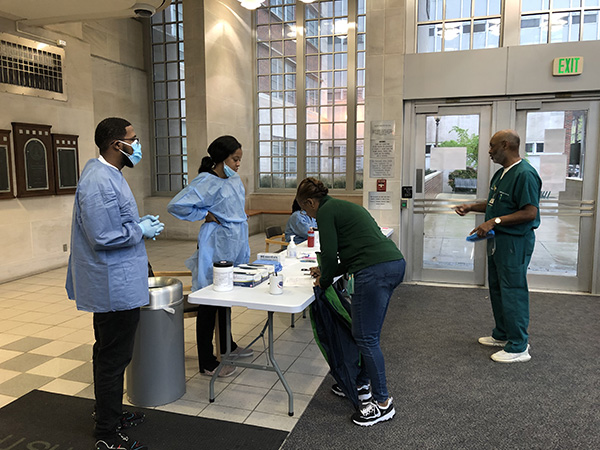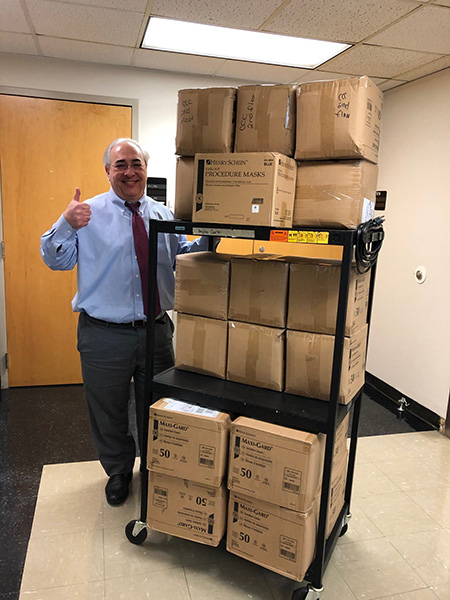It’s hard to imagine a world where the UAB School of Dentistry, its faculty and students aren’t focused on treating patients, learning, researching, and helping the underserved.
The COVID-19 pandemic has caused significant changes, but as Director of Clinical Operations Kathleen Diveley puts it, “The world keeps spinning, COVID-19 or not.” The school’s operations have undergone a major transformation the past several weeks. Here’s a look at two key areas:
Patient Care
 Faculty and staff manage school's COVID-19 screening stationThe patient load has dramatically declined from hundreds of people per day to about twenty. A skeleton crew of faculty are treating only patients who have bona fide emergencies and are primarily patients of record. “It’s our responsibility to take care of our patients with dental emergencies, and we want to take care of them before they have to go to the hospital emergency room,” said Dr. Perng-Ru Liu, Associate Dean for Clinical Affairs. All of the school’s clinical departments have faculty dedicated to the newly configured screening station and COVID-19 Emergency Clinic. Typical treatments include prescribing antibiotics for someone suffering from an infection, treating a patient who has a broken tooth or severe dental pain.
Faculty and staff manage school's COVID-19 screening stationThe patient load has dramatically declined from hundreds of people per day to about twenty. A skeleton crew of faculty are treating only patients who have bona fide emergencies and are primarily patients of record. “It’s our responsibility to take care of our patients with dental emergencies, and we want to take care of them before they have to go to the hospital emergency room,” said Dr. Perng-Ru Liu, Associate Dean for Clinical Affairs. All of the school’s clinical departments have faculty dedicated to the newly configured screening station and COVID-19 Emergency Clinic. Typical treatments include prescribing antibiotics for someone suffering from an infection, treating a patient who has a broken tooth or severe dental pain.
Faculty representing the departments of orthodontics, pediatric dentistry, and periodontology team up to perform initial screenings, a level and diversity of care patients rarely see. In the screening station, a rigid protocol is followed - body temperature is measured, and travel history, contact history, and specific symptoms are asked. From their screening, patients with acute problems are then triaged to the COVID-19 Emergency Clinic, which is managed by two general dentists or prosthodontists, one endodontist, and the oral and maxillofacial surgery team. The school has scaled back to seeing patients three days a week. “We have totally reconfigured everything. Our waiting room is roped off. Chairs are spaced six feet apart. Patient appointments are made in intervals. We have made our clinics as safe as possible,” said Diveley. One major notable difference of the newly configured treatment area is the absence of dental students.
Student Learning
The students are no longer in the clinics or at the school for that matter. The same holds true for residents of the specialty programs, although they remain in touch with their patients. UAB and UA System officials announced on March 12 that students would switch to an online/alternative instruction format. At the time, third year dental student Colby Bradford of West Pam Beach, Fla was preparing for spring break when he and his classmates learned they wouldn’t return for traditional instruction this semester. The first, second, and third year students are engaged with faculty through online instruction, mainly through Zoom. Senior dental students, known as D-4’s, are in the final weeks of finishing up various requirements for graduation.
 Taichman gives thumbs-up near PPE donations“We can’t see patients, but we are still learning,” said Bradford. “We are in a decent position because we had finished most of our didactic courses. I’ve been meeting with two classes: Dental Topics and Operative Dentistry. Our faculty have done a great job of taking advantage of technology,” he said. Several faculty are offering their courses through Zoom. Dean Russ Taichman has gotten in on the act, meeting regularly with students and faculty. While online, one’s screen could be filled with forty or fifty participants. The screen looks like a supercharged Hollywood Squares or Brady Bunch cast. “We’ve gotten pretty creative with some of the meetings,” said Taichman. “One meeting was a ‘happy hour’ where our faculty wore a favorite hat. It was hilarious. These are challenging times and everyone is working so hard to continue our mission. I thought it would be a nice ice breaker,” he said.
Taichman gives thumbs-up near PPE donations“We can’t see patients, but we are still learning,” said Bradford. “We are in a decent position because we had finished most of our didactic courses. I’ve been meeting with two classes: Dental Topics and Operative Dentistry. Our faculty have done a great job of taking advantage of technology,” he said. Several faculty are offering their courses through Zoom. Dean Russ Taichman has gotten in on the act, meeting regularly with students and faculty. While online, one’s screen could be filled with forty or fifty participants. The screen looks like a supercharged Hollywood Squares or Brady Bunch cast. “We’ve gotten pretty creative with some of the meetings,” said Taichman. “One meeting was a ‘happy hour’ where our faculty wore a favorite hat. It was hilarious. These are challenging times and everyone is working so hard to continue our mission. I thought it would be a nice ice breaker,” he said.
Students are still taking tests, and learning from one another. It’s just a different delivery mode. “I’ve had courses where the faculty voice over the lecture material. It’s uploaded to Canvas. I then spend three or four days studying the material before being tested on it,” said Bradford.
In the midst of it all, the school has also donated dozens of boxes of personal protective equipment (PPE) to UAB Hospital, totaling 4,900 isolation gowns, 4,300 surgical masks and 320 boxes of gloves.
Taichman and his administrative team still have to run the school, with most of the work being done remotely, making decisions on graduation (there will be one online May 30 and a traditional ceremony in December), and final grades, along with a myriad of other of immediate and long-term decisions. “Our students, faculty, staff, and alumni have been resilient throughout this ordeal. I want all of our constituents to know we are focused on safety first, and then continuing our clinical, educational, and research excellence as we move forward,” said Taichman.
There is a great desire for normalcy. For most everyone, that is having in-person relationships. Colby Bradford couldn’t agree more, “I miss my patients. I want to get back to my friends.”